Meteor Storm After Midnight Maybe, the Moon Masks A Leo Star, and Planets Parade in Predawn!

The scene viewed from Mexico City on Sunday, June 5 at 10:37 pm CDT, just before the moon begins to move in front of the bright star Al Jabhah, aka Eta Leonis. Timings vary by latitude and the hour varies with time zone. (From Stellarium)
Hello, Stars and Planets Fans!
Here are your Astronomy Skylights for the week of May 29th, 2022 by Chris Vaughan. Feel free to pass this along to your friends and send me your comments, questions, and suggested topics. You can also follow me on Twitter as @astrogeoguy! Unless otherwise noted, all times are expressed in Eastern Time. To subscribe to these emails please click this MailChimp link.
If you’d like me to bring my Digital Starlab portable inflatable planetarium to your school or other daytime or evening event, or deliver a session online, contact me through AstroGeo.ca, and we’ll tour the Universe, or the Earth’s interior, together! My terrific new book with John A. Read entitled 110 Things to See With a Telescope is a guide to viewing the deep sky objects in the Messier List – for both beginners and seasoned astronomers. DM me to order a signed copy!
This week, the moon will return to shine as a waxing crescent in the west after sunset, visiting Ceres and the Beehive, and occulting the bright star Eta Leonis as it slides east. In the eastern pre-dawn sky, Mars and Jupiter will dance telescope-close and then separate. Venus will rise after them and Saturn will begin a retrograde loop. Read on for your Skylights!
Possibility of a Meteor Storm!
Here’s a heads-up about a possible brief meteor storm (i.e., far more per hour than is usual) predicted for just after midnight Eastern Time (10 pm Mountain time) on Monday night, May 30-31, 2022!
A small comet discovered by German astronomers Friedrich Carl Arnold Schwassmann and Arno Arthur Wachmann on photographic plates taken at the Hamburg Observatory on May 2, 1930 was soon determined to be periodic, ranging between the orbits of Jupiter and Earth on a 5.4 year cycle. It has since been named 73P/Schwassmann-Wachmann-3 (or SW3, for short). With a rather small core, it has been an unimpressive denizen of our solar system, its appearances typically requiring a telescope.
During its predicted return in the autumn of 1995, the comet unexpectedly flared to such a brightness that astronomers could see it with unaided eyes. Close-up images revealed that it had fragmented into four large chunks several weeks after passing the sun at perihelion. Views by the Hubble Space Telescope, the Spitzer Space Telescope, and other observatories during the 2006 return, and more observations in 2017, showed that the comet has continued to break apart into many dozens of pieces.
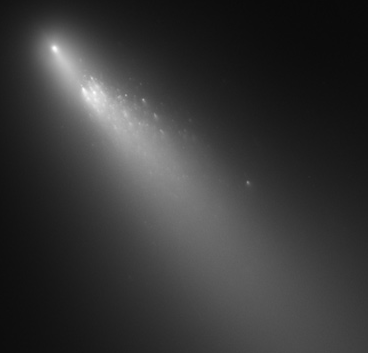
As with many comets that have orbits that intersect Earth’s, encounters with the SW3 debris have generated a minor meteor shower known as the Tau Herculids, which peaks around June 9 annually. Since 2004, several researchers have investigated whether the 1995 break-up of the comet could have produced enough new debris to produce a meteor outburst or storm. In 2021, Joe Rao, News 12 meteorologist and instructor at New York’s Hayden Planetarium, published a paper in the Journal of the International Meteor Organization (IMO) describing a modeling study he carried out on the SW3 debris. Rao suggests that, if the particles generated by the comet’s 1995 break-up were ejected at sufficiently high velocities to avoid dispersal by the sun’s radiation pressure, they would have migrated to a position ahead of the comet in its orbit. If so, Earth will pass through a dense cloud of them at 1 am EDT (or 05:00 UTC) on May 31, 2022. You can read Joe Rao’s paper yourself here, his recent post on FaceBook here, Joe’s update from Sky & Telescope Magazine here, and a NASA web page here.
The meteor streaks across the sky we see are brighter and longer if the particles are hitting Earth’s atmosphere at high speed. Thinking of the Earth as a car driving on the highway (our orbit around the sun), any meteors “rear-ending us” from behind are slower and less energetic than those hitting us head-on. Impacts at right angles to our orbit fall between those velocities. The well-known Lyrids meteors are the fastest at 72 km/s. The Perseids meteors we see in August hit Earth’s atmosphere at 59 km/s. The predicted speed of Monday’s meteors is 12.5 km/second, close to the minimum for any meteor shower. Anything that slow will likely produce fainter, short streaks coloured dull orange.
No one can be sure whether we’ll see nothing at all, or a terrific show of hundreds – perhaps thousands – of meteors streaking across the night sky over the space of a few hours. Observers in North and Central America located southeast of an arc running from Los Angeles to James Bay will have the best opportunity because their skies will be fully dark and moonless around the peak time, and the radiant’s location will be very high in the western sky, an ideal position for seeing the most meteors. Rao predicts a very broad radiant centred around the star 12 Bootis, which sits to the upper right of very bright Arcturus. For folks in the northwestern USA and southern British Columbia and Alberta, the sky will not yet be dark after sunset – but the tail end of any shower may be visible after dusk.
If you don’t mind the risk of being disappointed, find a wide-open, dark location, preferably away from light polluted skies and artificial lights, and just look up with your unaided eyes. The fields of view of binoculars and telescopes are too narrow to be useful for meteors – but you’ll be glad you have them to look at other things if no meteors appear! Don’t spend too much time watching the radiant because the meteors appearing near that location will be short. Try not to look at your phone’s bright screen – it’ll ruin your night vision. Just keep your eyes heavenward – even while you are chatting with companions. Long exposure images on a tripod-mounted camera can capture multiple meteors.
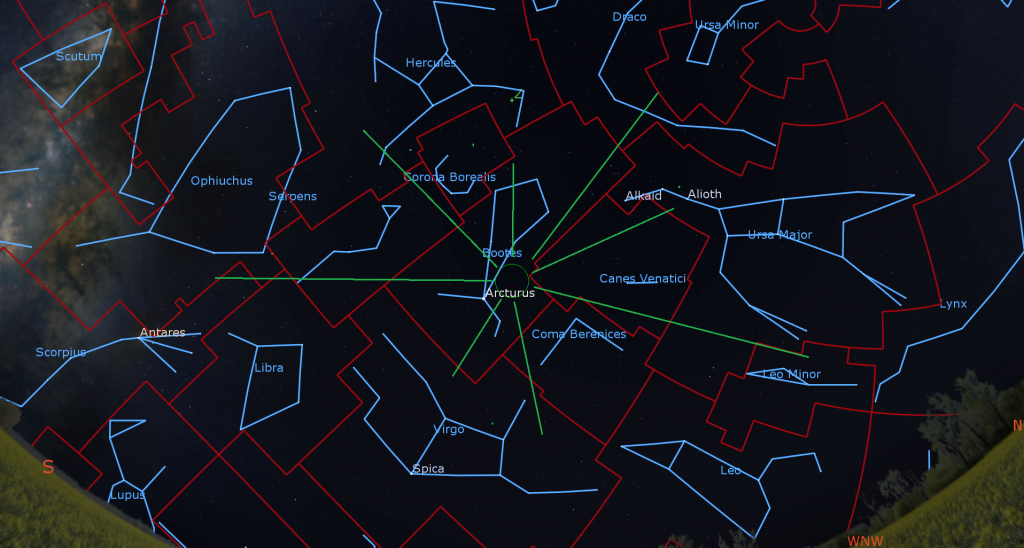
Plan to start watching no later than midnight Eastern Time (although some meteors could appear before then). The show should be over by about 2 am EDT. (The peak times in other time zones are: 2 am ADT, 12 am CDT, 11 pm CMT, and 10 pm PDT.) Don’t forget to bundle up, clear skies, and good luck!
The Moon
The moon will return to shine in evening skies worldwide this week. First, though, it will need to pass the sun on Monday morning at 7:30 am EDT or 11:30 Greenwich Mean Time – the official new moon phase. At that time our natural satellite will be located in Taurus (the Bull), and less than 1 degree north of the sun. Since sunlight can only shine on the far side of the moon, and the moon is in the same region of the sky as the sun, the moon will be completely hidden from view from anywhere on Earth until its extremely thin crescent appears above the west-northwestern horizon, bathing in the post-sunlight twilight, on Tuesday evening.
The moon will be easier to see from Wednesday onwards as it slides east of the sun, allowing our natural satellite to fill with light and set an hour later each night. Watch for Earthshine, or the Ashen Glow, during the beginning of this week. That’s sunlight reflected off Earth that slightly brightens the unlit portion of the moon’s Earth-facing hemisphere.
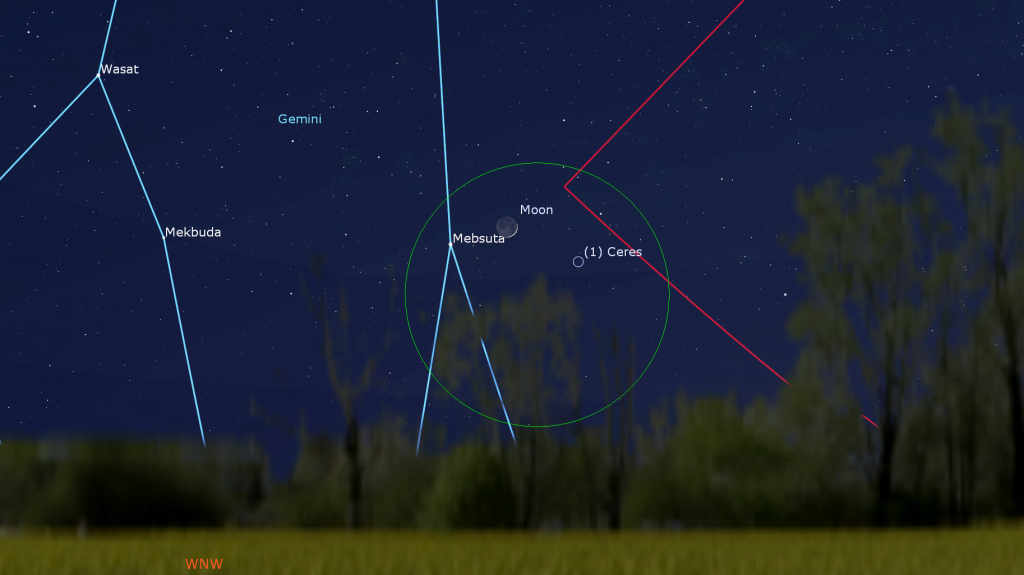
When the pretty, young crescent moon appears low in the northwestern sky after sunset on Wednesday, June 1, it will be positioned a thumb’s width to the right (or 1.6 degrees to the celestial northwest) of the medium-bright star named Mebsuta in Gemini (the Twins). That star marks the waist of Castor, the westerly twin. The dwarf planet (formerly largest asteroid) designated (1) Ceres will be located a similar distance to the moon’s lower right. All three objects will share the view in binoculars, but clearly seeing Ceres’ magnitude 8.9 speck will require a backyard telescope. On Thursday night, the moon will climb higher, shining below the bright star Pollux.
On Friday night, the easterly orbital motion of the waxing crescent moon will carry it past the huge open star cluster in Cancer known as the Beehive, Praesepe, and Messier 44 in the western sky. After dusk in the Eastern Time zone, the moon will be shining a slim palm’s width to the right (or 5 degrees to the celestial northwest) of the cluster. More westerly observers will see the moon somewhat closer to the Beehive after dusk. The moon and the cluster will be close enough to share the field of binoculars, but you’ll see more of the “bees” if you hide the moon just outside of their field of view.
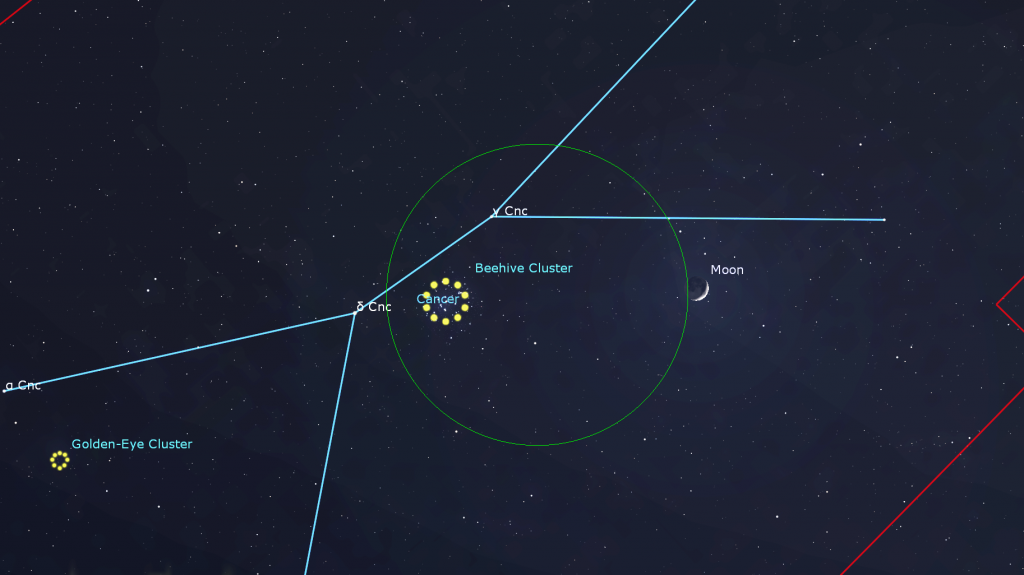
On Saturday and Sunday evening, the moon will be poised to the lower right of the bright stars of Leo (the Lion). The lion’s face and head form a backwards question mark shape that will be leaning to the right. On Sunday evening, the moon will shine less than a finger’s width to the lower right (or celestial west) of the star Al Jabhah (or Eta Leonis). It emits up to 20,000 times more light than our own sun, but its distance of 1,270 light-years makes it dim enough to shine near the limit of visibility for suburban stargazers. You can use binoculars to watch the moon slide just below that star before they set together around 1 am local time. Folks viewing from the Caribbean and farther south can see the moon occult Al Jabhah starting before 10:30 pm Central Time! The timing depends on your latitude. For Mexico City, the star will be covered by the dark leading edge of the moon at 10:38 pm CDT. It will emerge from behind the bright opposite side of the moon at 11:37 pm.
The Planets
The bright planets in the eastern pre-dawn sky are putting on quite a show! On Monday and Tuesday morning the small red disk of Mars and Jupiter’s big orb will appear together in the eyepiece of a backyard telescope at low power! Jupiter’s four largest moons will accompany them, including the small, black shadow cast on Jupiter by Io on Monday only. In the sky, the two planet will shine as a close-together pair sitting low in the eastern sky after they rise together around 3 am in your local time zone. They’ll remain visible until almost sunrise. Fifteen times fainter Mars will be hidden by the brightening sky first.
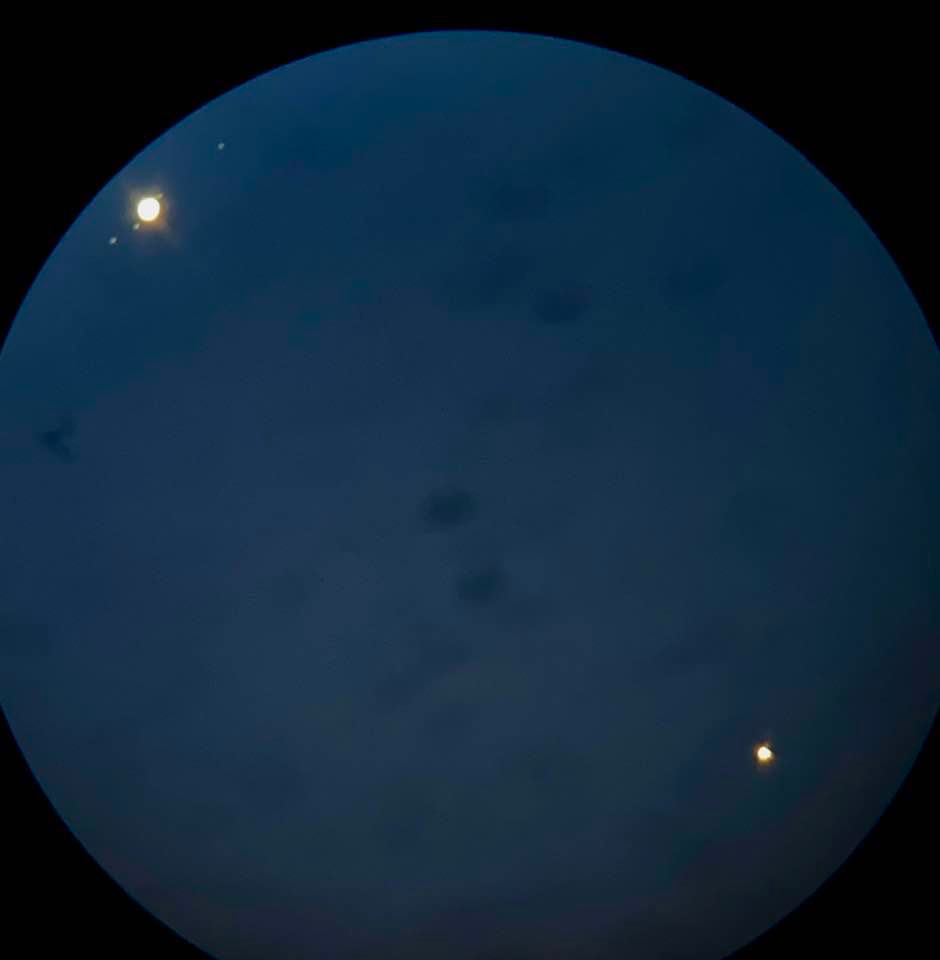
Those two planets are in the middle of a long chain of bright planets. Now that Mars will sit slightly to the left (or celestial east) of Jupiter, and increasing that separation each morning, five bright planets will soon be shining in the eastern pre-dawn sky, arranged in order of their distance from the sun – for the rest of June! Early risers can also look for the pale yellow dot of Saturn shining almost four fist diameters to the upper right (or 38 degrees to the celestial west) of Mars-Jupiter. It rose around 1:30 am local time. Extremely bright Venus will rise to join them all after 4 am.
But there’s more there than meets the eye! The main belt asteroid named (4) Vesta will be traveling a palm’s width below and to the lower left (or 7° to the celestial southeast) of Saturn – but you’ll need good binoculars or a backyard telescope to see its magnitude 7.1 speck. Faint, blue Neptune will be lurking almost a fist’s width to Jupiter’s upper right (celestial west). Uranus will rise to Venus’ lower left around 4:30 am local time. Its magnitude 5.9 blue-green dot will become more visible after it passes close to Venus next week.

Mercury is also west of the sun now, but its position well below (or celestial south of) a slanted morning ecliptic will prevent observers at mid-northern latitudes from seeing the speedy planet until it swings farther from the sun in the coming weeks. Observers in the tropics and farther south can spot the planet this week. Once it moves clearly into view after June 10, that planet conga line will be complete!
Saturn will be swimming among the stars of eastern Capricornus (the Sea-Goat) until next February. On Sunday, June 5, the eastward prograde motion of the ringed planet through those background stars will slow to a stop. After that it will commence a westward retrograde loop that will last until late October. Retrograde loops occur when Earth, on a faster orbit closer to the sun, passes more distant planets “on the inside track”, making them appear to move backwards across the stars.
Mars, Jupiter, Uranus, and Neptune will each start a retrograde period in the coming weeks and months. The next most westerly planet, Neptune, will enter retrograde on June 28. While planets are in retrograde, Earth is closer to them, giving us our best views in binoculars and telescopes while they look larger and brighter. As a bonus, they start rising in late evening. Saturn will rise before midnight from the third week of June onward – kicking off the 2022 evening planets season!
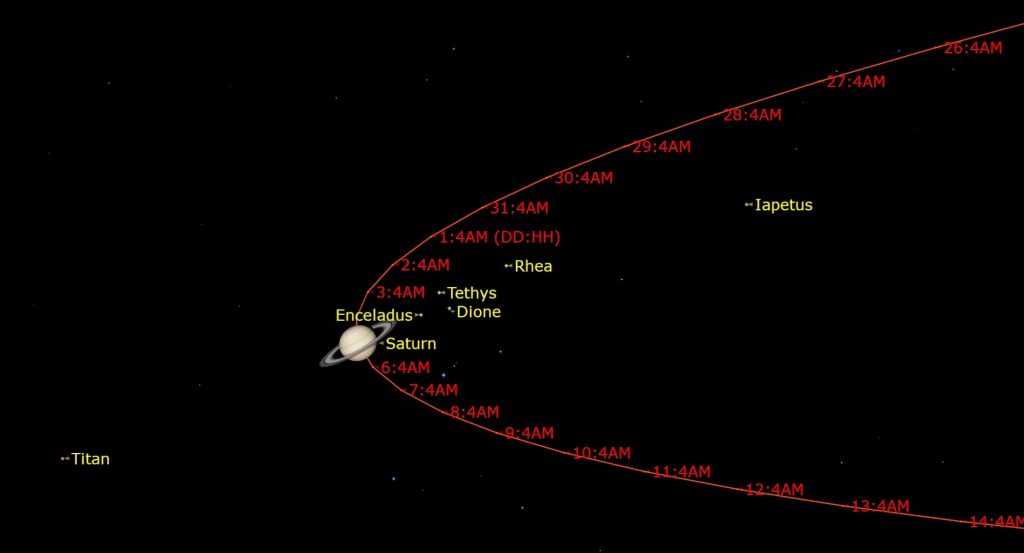
Any size of telescope will show you Saturn’s full globe extending above and below its rings, and a few of its moons. Venus will exhibit a waxing football-shape in a telescope or in good binoculars. Mars will shine with a tiny, 88%-illuminated disk. Flanked by its four Galilean moons, Jupiter’s much larger disk will feature dark bands running parallel to its equator, the Great Red Spot on Tuesday, Thursday, and next Sunday morning, and the small back shadow of Io’s disk on Monday morning.
Turn all optics away from the east before sunrise, please!
If you are up early to see the planets, seek out the Andromeda Galaxy (Messier 31) in the east-northeast and the bright globular clusters Messer 2 and Messier 15 near Enif, the nose star of Pegasus. Over to the south, the summertime Milky Way will be rising through Sagittarius (the Archer), Scutum (the Shield), Aquila (the Eagle), and Cygnus (the Swan).
Peering at the Ploughman
The early-setting moon during evening this week, and the lovely late spring nights, offer a fine opportunity to explore the realm of Boötes (“Bow-OH-tees”), the Herdsman or Ploughman. I toured his stars last week here.
Public Astro-Themed Events
Every Monday evening, York University’s Allan I. Carswell Observatory runs an online star party – broadcasting views from four telescopes/cameras, answering viewer questions, and taking requests! Details are here. They host in-person viewing on the first clear Wednesday night each month. Other Wednesdays they stream views online via the observatory YouTube channel. Details are here.
On Wednesday evening, June 1 at 7:30 pm EDT, the RASC Toronto Centre will live stream their monthly Recreational Astronomy Night Meeting at https://www.youtube.com/rasctoronto/live. Talks include The Sky This Month presented by ME!, another look at astronomy clubs in high schools, and equipment upgrades for Schmidt-Cassegrain Telescopes (SCTs). Details are here.
On Thursday, June 2 at 8 pm EST, the Department of Astronomy & Astrophysics at the University of Toronto will stream their AstroTour. The live, free event will feature PhD Candidate Anna O’Grady discussing Twists and Turns while Searching for Strange Stars. Details and the YouTube link are here.
Eastern GTA sky watchers are invited to join the RASC Toronto Centre and Durham Skies for solar observing and stargazing at the edge of Lake Ontario in Millennium Square in Pickering on Friday evening, June 3, from 7 pm to midnight. Details are here. Before heading out, check the RASCTC home page for a Go/No-Go call – in case it’s too cloudy to observe.
My free, family-friendly Insider’s Guide to the Galaxy webcasts with Samantha Jewett of RASC National returns on Tuesday, June 7 at 3:30 pm EDT, when we’ll celebrate our Globular Cluster Spectacular and hand out the Globie Awards for the best ones to look at! Plus, we’ll continue with our Messier Objects observing certificate program and share some galaxy-viewing tips. You can find more details and the schedule of future sessions here.
Don’t forget to take advantage of the astronomy-themed YouTube videos posted by RASC Toronto Centre and RASC Canada.
Keep looking up, and enjoy the sky when you do. I love questions and requests. Send me some!